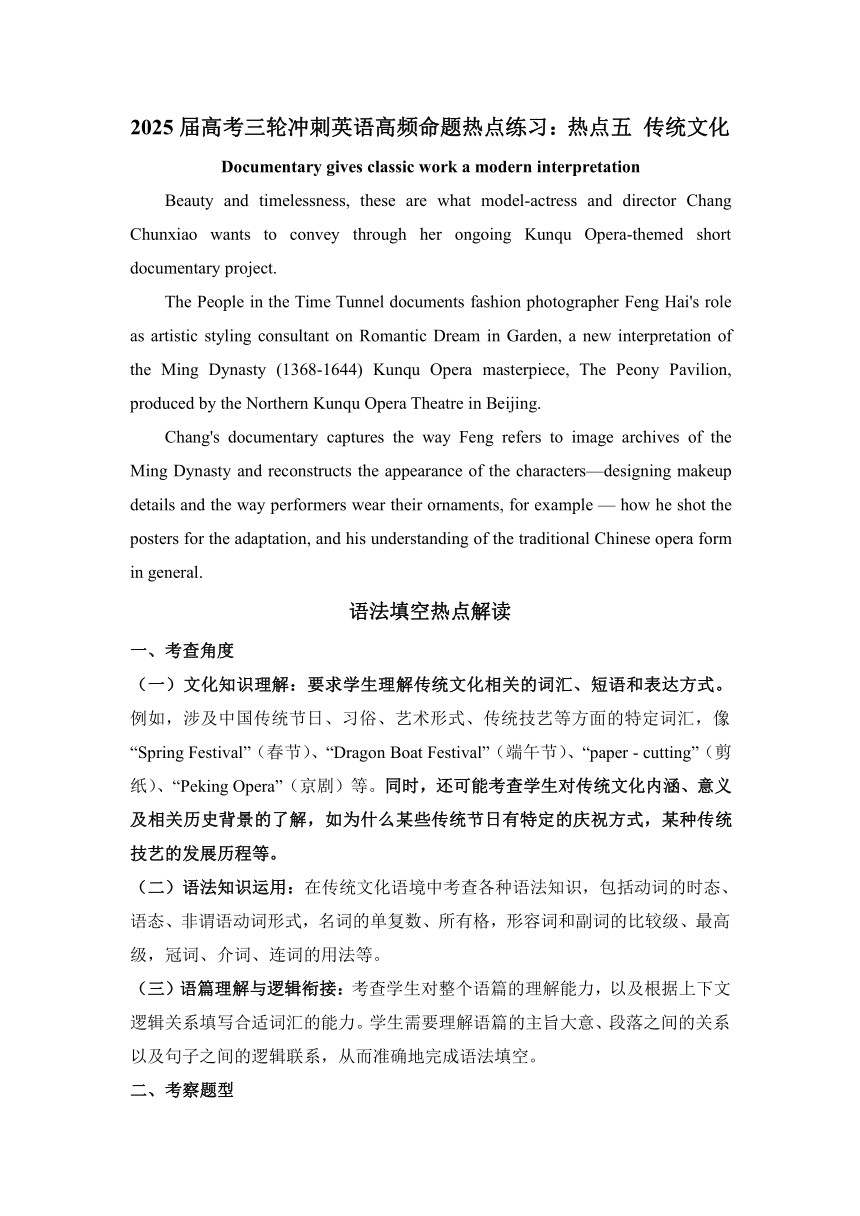
2025届高考三轮冲刺英语高频命题热点练习:热点五 传统文化 Documentary gives classic work a modern interpretation Beauty and timelessness, these are what model-actress and director Chang Chunxiao wants to convey through her ongoing Kunqu Opera-themed short documentary project. The People in the Time Tunnel documents fashion photographer Feng Hai's role as artistic styling consultant on Romantic Dream in Garden, a new interpretation of the Ming Dynasty (1368-1644) Kunqu Opera masterpiece, The Peony Pavilion, produced by the Northern Kunqu Opera Theatre in Beijing. Chang's documentary captures the way Feng refers to image archives of the Ming Dynasty and reconstructs the appearance of the characters—designing makeup details and the way performers wear their ornaments, for example — how he shot the posters for the adaptation, and his understanding of the traditional Chinese opera form in general. 语法填空热点解读 一、考查角度 (一)文化知识理解:要求学生理解传统文化相关的词汇、短语和表达方式。例如,涉及中国传统节日、习俗、艺术形式、传统技艺等方面的特定词汇,像 “Spring Festival”(春节)、“Dragon Boat Festival”(端午节)、“paper - cutting”(剪纸)、“Peking Opera”(京剧)等。同时,还可能考查学生对传统文化内涵、意义及相关历史背景的了解,如为什么某些传统节日有特定的庆祝方式,某种传统技艺的发展历程等。 (二)语法知识运用:在传统文化语境中考查各种语法知识,包括动词的时态、语态、非谓语动词形式,名词的单复数、所有格,形容词和副词的比较级、最高级,冠词、介词、连词的用法等。 (三)语篇理解与逻辑衔接:考查学生对整个语篇的理解能力,以及根据上下文逻辑关系填写合适词汇的能力。学生需要理解语篇的主旨大意、段落之间的关系以及句子之间的逻辑联系,从而准确地完成语法填空。 二、考察题型 (一)有提示词题型:通常会给出一个单词,要求学生根据句子的语法结构和上下文语境,将其变成适当的形式。例如,给出 “tradition”,可能需要学生填 “traditional”(形容词形式,修饰名词)或 “traditionally”(副词形式,修饰动词或形容词);给出 “celebrate”,可能要填 “celebration”(名词形式)或 “is celebrated”(被动语态形式,用于描述某个节日被庆祝)等。 (二)无提示词题型:需要学生根据上下文的逻辑和语法关系,填写适当的虚词,如冠词、介词、连词、关系代词或关系副词等。比如,在 “Spring Festival is _____ most important traditional festival in China.” 中,需要填定冠词 “the”;在 “People eat mooncakes _____ the Mid - Autumn Festival.” 中,要填介词 “on” 或 “during”;在 “I like Chinese kung fu, _____ is very popular around the world.” 中,要填关系代词 “which” 引导非限制性定语从句。 三、答题技巧 1. 快速浏览全文:先通读全文,了解语篇的主题是关于哪种传统文化,大致内容和结构是怎样的,明确文章的时态和整体风格,为后续答题奠定基础。 2. 分析句子结构:对于有提示词的题目,仔细分析句子的成分,确定所填词在句中的作用,是作主语、谓语、宾语还是定语、状语等,从而确定词的正确形式。对于无提示词的题目,根据句子之间的逻辑关系,如因果、转折、并列、递进等,以及语法规则来判断应填的词。 3. 注意上下文语境:答案往往要根据上下文来确定,不能孤立地看一个句子。例如,名词的单复数可能要根据上下文提到的数量来判断, ... ...
~~ 您好,已阅读到文档的结尾了 ~~